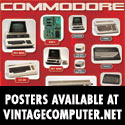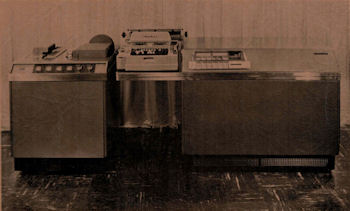Commodore B Series Tips and Tricks
SHARE |
|
  Commodore B Series Tips and Tricks
Commodore B Series Tips and Tricks |
by Bill Degnan - 05/19/2006 06:39 |
|
Commodore B Series Tips and Tricks B 128 and CBM 256-80
By Bill Degnan 1. Get as many CBUG disks as you can, as well copies of the resources listed at the bottom of this document. You will also need to track down a copy of SuperScript II so that you can read B Series word processing files. SuperScript II, the B Series Commodore User's Guide, and the Programmer's Reference can be purchased from vintagecomputer.net. Freeware utilities, IEEE drive manuals, and B series commercial software can also be purchased from this source. 2. You will need a PET to IEEE cable to connect peripherals (such as disk drives) to the B series. 3. To activate most commercial software; attach everything and with the program diskette in drive 0 hit the SHIFT+RUN/STOP keys. 4. Most software written for the B Series computers is ONLY compatible with the 8050 IEEE diskette drive. You can use other Commodore IEEE drives such as the 8250 and SFD-1001, but you will have to run a BASIC program to emulate "8050 mode" first, before your software will work. 5. You can't run C 64/128 software on a B. You can't run Plus/4 software either. You *can* run PET 8032 software using an 8032 emulator called 8432” that is found on CBUG #1. It works pretty well. TBUG has PET software if you can't find any here. 6. Not all Commodore monitors are compatible with the B's video signal. My favorite monitor for the B (assuming you don't have a high profile unit with built-in monitor) was made by US International, model VM1230. This monitor was distributed by Protecto Corp among others. A closed circuit TV is good. A Commodore 1701/1702/etc. will do in a pinch but the characters will not be as sharp. For example you'll have trouble differentiating between a single and double quote. 7. For a B-128, the opening screen after successful initialization of the computer is: *** commodore basic 128, v4.0 *** 8. For a CBM 256-80, the opening screen after successful initialization of the computer is: *** commodore basic 256, v4.0 *** 9. If you're using a standard Commodore video cable, don't attach the audio jack from the video cable to the monitor. On a B the audio signal is not sent with the video signal (like a C 64); instead you'll need a 1/8 in mono jack plugged into the audio port of the B and then cabled separately to the audio input port of your monitor 10. The B's use the same polyphonic SID chip as the C64! Unfortunately the command POKE's are different. You have to convert audio written for the C64 first before you can play it on a B. See The Commodore B 128 Programmer's Reference Guide for details. Given the extra horsepower of the B vs. a C64, there is the potential for even better audio! 11. Make sure your IEEE cables are grounded properly. If your screen display "rolls" while in operation, it could be due to an improperly grounded IEEE cable. Some 8050 drives will cause the monitor display to roll no matter what you do. Try keeping them separated. 12. Can't read or write to diskettes? a. Clean the single-sided drive head with a high-percentage isopropyl alcohol (90%+). b. The spin of U.S. 8050 IEEE drives must be 300 RPM. A program for testing the drive speed can be found on CBUG release disk #83 c. Before you use a disk you must format it. The command is: header "disknamehere", d0, i01 (assuming you have a disk in drive 0 of an 8050 drive). NOTE: i01 assigns the identification name/number; 01” can be substituted for any two alpha characters. d. The command: ?ds$ will tell you if the processor board of the disk drive is OK or not. The response you want will be something like: "73, cbm dos v. 2.x" e. If your drive lights are blinking, use the user's guide to diagnose the blink pattern for hardware problems. f. Carefully press tight and/or re-seat chips to strengthen IC connections to board. 13. To copy files to and from non-B systems a. BeeLine v.2.1 terminal software XMODEM. Try an AVATEX modem. b. Copy files from IBM format using CMD's WCOPY+ software, attach a IEEE/serial converter to a C-64/128 computer so that you can interface with an IEEE drive and voila! (sort of) It ain't easy! c. I have never done this before, but you can use the FAST BUS system developed by CBUG members. See CBUG #84 for details. I have some parts for this system, but have not attempted as of this writing. 14. Before powering up a 8050 drive, remove all diskettes to avoid accidental destruction of data. This can happen! 15. Working B Series diskettes are precious, so make diskette backups! Here are some options: a. On a 8050 drive assuming the source is in drive 0, destination is in drive 1: COPY D0 "sourcefile" TO D1 "destfile" (copy only, don't format) BACKUP D0 TO D1 (formats dest. disk in drive 1 first and copies all) b. CBUG #46 has a utility called copy-all b128.4” by Liz Deal that I like. 16. Most word processing for the B Series was done with SuperScript II. The file extension is SEQ. 17. Most database programming for the B Series is was done using SuperBase. The file extension for SuperBase files is also SEQ, so if you can't read a file in SuperScript, try SuperBase (or SuperOffice). 18. A B-128 can get pretty hot. If you place a fan to blow lightly on the computer you will prolong its life. Don't store diskettes on top of the B-128, or 8050 drive for that matter. Reply |
|
  CBM IEEE Drive Tips
CBM IEEE Drive Tips |
by Bill Degnan - 08/01/2010 13:07 |
|
The following was taken from Commodore service manuals and technical news letters, plus CBUG. Post date is last update, this record will be updated as new tips are located.
Download PDF. The most useful thing here is the match between the blink codes and the location on the PCB/part that is faulty. Drives: 8050 2031 9060 9090 See also More Commodore IEEE Drive Blink Codes If the drive seems OK but will not locate (file not found) or run programs, try this: open1,8,15,"I" (return) ...this command will help the drive head find its way back on track. That and cleaning the drive head itself with isopropyl alcohol is often the solution to a lazy drive. Reply |
|
Resources:

Popular Topics and FAQs
Past Issues:
Before we switched over to a blog format, past page archives here:
Vintage Computer Festival East 3.0 June 2006
Commodore B Series Prototypes July 2006
VOLSCAN - The first desktop computer with a GUI? Oct 2006
ROBOTS! - Will Robots Take Over? Nov 2006
Magnavox Mystery - a Computer, or? Jan 2007
The 1973 Williams Paddle Ball Arcade Computer Game Feb 2007
The Sperry UNIVAC 1219 Military Computer May 2007
VCF East 2007 - PET 30th Anniversary June/July 2007
The Electronic Brain August 2007
Community Memory and The People's Computer Company October 2007
Charles Babbage's Calculating Machine December 2007
Vintage Computing - A 1983 Perspective February 2008
Laptops and Portables May 2008
From Giant Brains to Hobby Computers - 1957 to 1977 August 2008
Historic Computer Magazines November 2008
World's Smallest Electronic Brain - Simon (1950) December 2008 - Feb 2009
Free Program Listings Spring 2009
Computer Music Summer 2009
Popular Electronics Jan/Feb 1975 - Altair 8800 Fall 2009
Early Microcomputer Mass Storage Summer 2010
Royal McBee Royal McBee LGP 30

This image was selected at random from the archive. Click image for more photos and files from this set.